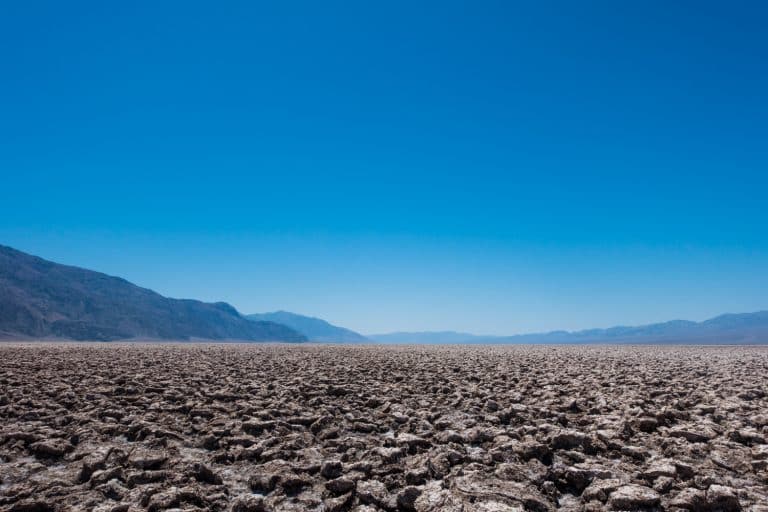Death Valley is a National Park of extremes. It’s the hottest place on earth, the driest place in the United States, and the lowest point in North America. These conditions result in an interesting landscape, making the place worth a visit. Below, we summed up some of the best viewpoints in Death Valley National Park California.
The Best Viewpoints in Death Valley National Park
Apart from being the hottest, driest and lowest, Death Valley is also the largest US National Park outside Alaska. 91% of its 3.4 million acres is protected as officially designated Wilderness. Expect dry and desolate landscapes, rugged mountains, and seemingly endless salt flats.
The Death Valley landscape actually reminded us of The Breakaways in Australia, with colours ranging from red, over brown and orange, to yellow, even some greenish. Except this was way bigger, hotter, and with paved roads.
Now, without further ado: the best viewpoints in Death Valley National Park California, in order of which we visited them.
Dante’s View
It’s a short walk over a dirt path to get to Dante's View from the car park. This spectacular viewpoint watches out over the salt flat covering the floor of Death Valley, 5,475 ft (1,699 m) below. Because of the height it’s slightly cooler and more windy up there. It’s supposed to offer one of the best sunrises in the park, but we didn’t have time to stick around to find out.
Note: the paved road leading up to the car park is prohibited for vehicles longer than 25 ft (7.6 m).
Zabriskie Point
From the car park it’s a short uphill walk to Zabriskie Point. The viewpoint looks out over heavily eroded badlands. It’s one of the most famous viewpoints in Death Valley National Park, and a popular spot to watch both sunrises and sunsets.
During the short walk up to Zabriskie Point some kind of chipmunk (I guess?) crossed the path. We also noticed a little purple flower growing in the dirt. Mind the details, Death Valley National Park isn’t dead. Despite its name it sustains life as well, albeit small.
Devil’s Golf Course
One of the most impressive viewpoints in Death Valley National Park is the Devil's Golf Course. It looks like a plowed field, dried by the burning sun and topped with salt. A surreal view. In reality it’s rock salt eroded by wind and rain. “Only the devil could play golf on such rough links”.
Apparently you can hear tiny pops and pings coming from the Devil’s Golf Course when you listen carefully. It’s the sound of the billions of tiny salt crystals bursting because of the heat. We only read about it after our visit though, so can’t confirm.
Note: the dirt road leading up to the Devil’s Golf Course is often closed after rain.
Badwater Basin
Badwater Basin is the lowest point in Death Valley National Park (and even North America!). It’s a huge salt flat, 282 ft (86 m) below sea level. To get an idea how low this is, look for the sign on the side of the mountains behind you that indicates sea level.
You can see pretty much everything from the car park, but we still walked all the way to the white part of the salt flat for some photos. It – was – SO – hot! Still, Badwater Basin was the busiest viewpoint in Death Valley National Park during our visit.
Artist’s Palette
Then there is Artist's Palette. It’s a stop along Artist’s Drive, a one way scenic loop drive along Badwater Road. During the drive you’ll be surrounded by hills displaying a varied palette of colours: from shades of pink over yellow to mold green. For the best photos you should visit in the late afternoon, when the light’s optimal.
Note: this 9 mile (14.5 km) paved road is one way only and prohibited for vehicles longer than 25 ft (7.6 m).
Mesquite Flat Sand Dunes
And finally, another viewpoint in Death Valley National Park that’s definitely worth a visit: the Mesquite Flat Sand Dunes. It’s quite different to the other viewpoints and reminds more of a traditional sand desert.
Take note that the sand can be HOT. Sandals were not ideal for walking over the dunes.
Death Valley National Park – Practical Information
Did this convince you to visit Death Valley National Park? Then keep reading for some practical information to plan your visit to the hottest, driest and lowest National Park.
Death Valley National Park Visitor Center
Before you start exploring Death Valley National Park, you should drop by the Furnace Creek Visitor Center. Pay your entrance fee here, or buy an annual pass, like we did. There’s a museum with tons of information on Death Valley National Park and its flora and fauna, a souvenir shop, and free, but slow WiFi. You can use their clean toilets and fill your reusable bottles with drinking water.
Talk to a park ranger about where to go and get some up-to-date information on Death Valley, the weather, and other stuff. You can pick up a map of the park as well, and a visitor guide. It looks like a newspaper and is updated every season with seasonal advice and information on current projects.
At Furnace Creek there are also campgrounds, a picnic area, a gas station, an airport and even a golf course.
Entrance Fee for Death Valley National Park
There are different entrance fees depending on how you enter the park: by car or motorcycle. The entrance fee for a single private, non-commercial vehicle is $25 for 7 days of unlimited leaving and re-entering the park.
When you plan on visiting several National Parks within a year, an annual national park pass is the smarter option. We bought an America the Beautiful Annual Pass, costing us $80. It’s valid for one year, for all US National Parks. You need 1 per car, but the card allows for 2 signatures, meaning you can share it with someone else. Whenever you enter a National Park you have to show this card, together with your ID.
Discount passes are available for children, senior US citizens, US citizens with permanent disabilities, and US military personnel. You can find more information on the official Death Valley National Park Service website.
Visiting Death Valley National Park in Summer
Summer in Death Valley National Park is from May through October. Temperatures may exceed 120°F (49°C) during the day and won’t drop below 90°F (32°C) at night. The weather is hot and dry, and there’s no shade, nowhere. We should know, we visited in June 2016, when temperatures climbed up to 111°F (44°C).
Make sure you bring enough water. Rangers recommend 1 gallon or 3.8 liters per person per day. Something to cover your head, protecting it from the burning sun, is nice too. And apply lots of sunscreen. If you must hike (not recommended), do it early. And last but not least, you really want a car with air-conditioning when visiting Death Valley National Park.
Visiting Death Valley National Park in Winter
Let’s call all the other months (November through April) winter in Death Valley National Park. Temperatures drop to a pleasant level, below 86°F (30°C), with generally sunny and dry weather. A rare rainstorm in winter will bring wildflowers in spring, making the months of February to April the most popular time to visit the park.
Even though it’s not scalding hot, still bring enough water. In winter you may need warm clothes, but spring temperatures definitely allow for shorts.
Death Valley National Park in numbers
- Hottest place on earth: holds world record for hottest air temperature 134°F (57°C)
- Driest place in the US: 2.2 inches (5.6 cm) of rain a year
- Lowest point in North America: Badwater Basin is 282 ft (86 m) below sea level
These 5 viewpoints in Death Valley National Park are all impressive in their own way. We were fascinated by the colours of Artist’s Palette and blown away by the Dante’s View. Death Valley may not be one of the most popular National Parks, but we hope to have convinced you pay it a visit nonetheless!
Have you already visited these awesome viewpoints in Death Valley National Park? Did we miss out on any? We’d love to read about your experience in the comments!
Like it? Pin it!
Did you find this post helpful? Help us spread the word by sharing this post or pinning the following image.

















